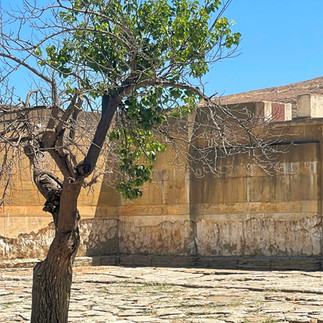Things to Know when Visiting Knossos Palace and Heraklion Archeological Museum on Crete Greece
- Tina Walsh
- Oct 26, 2021
- 4 min read
Updated: Jul 29, 2023

Seven miles from Old Town Heraklion, in central Crete, stands Knossos Palace. This archeological was the largest of Minoan Palaces and home to the Kings of the Minoans. The Neolithic Minoan culture existed on Crete from 7000 BCE to 1300 BCE. They were a sophisticated culture who traded with the early Egyptians, had a written language, used coins for trade and made wine and olive oil.
These were the people who imagined the Labyrinths and Minotaurs that were later featured in Greek Mythology. This site was discovered in 1878 and excavated between 1900 - 1931. The artifacts that were unearthed can be found in the Heraklion Archeological Museum in Old Town Heraklion. We visited Knossos Palace one day and the Heraklion Archaeological Museum later in the week.
Knossos Palace

The site is easy to find and there is lots of free parking. The line is very long to purchase tickets. We did not purchase tickets in advance, but I would highly recommend you do.
To avoid waiting in line, we decided to join a small group guided tour with head of the line privileges. The cost of the small group, guided tour and skip the line tickets was 40 euro for two persons. The tour was very informative and gave a background information on who were the Minoans and how they lived. I would recommend this option if your visit is spur of the moment or you are unsure which day you want to visit the Palace.
If you can plan in advance, there are lower cost options available to you. You can purchase Skip the Line tickets with an audio tour for 20 euro, using the link below. The site opens at 8:00 am daily and closes between 3:45 pm and 7:45 pm depending upon the time of year. There are restrooms, a gift shop and a small cafe on the premises.The regular entrance fee is 15 euro. I would highly recommend advance purchase of your entrance tickets, it is worth the 5 euro and you get an downloadable audio tour..
The Palace is a multiple story complex that takes up the space of two football fields. There are Royal bedrooms, a throne room, storage facilities and craftsmen workshops. The excavation was done by the British Archeologist, Arthur Evans. He attempted to recreate the Palace as he excavated it. With the hindsight of 100 years of archeological advancements, the re-creation receives criticism. However, it does give the average visitor great insight into the lives of Minoans.
There are more questions and mysteries than answers surrounding Knossos. The original palace dates back to 1950 BCE. Whether it was damaged in an earthquake or simply expanded and renovated, the new palace is the structure we see today. Around 1300 BCE, the Minoan society ceased to exist. The best educated guess is that there was a Tsunami that killed most of the population and the surviving population assimilated into Mycenaean society.
The frescos and artwork that decorated their pottery illustrates what was important to this culture and how they lived their lives. The Palace was built next to a spring fed river which was diverted to bring fresh water and carry away sewage from the Palace. Farming and goat herding were the primary sources of food. Wine and olive oil was used as currency to pay taxes to the King and trade with other island countries.
Heraklion Archaeological Museum

We arrived early in the morning to visit the Heraklion Archaeological Museum before it got crowded. This museum houses ancient artifacts that have been found on Crete. Specifically it covers the neolithic and historic periods from 7000 BCE to 200 ACE. The museum was founded in 1908 to showcase the artifacts found with the excavation of Knossos Palace.
The current museum was built between 1937 and 1958 on the site of a Venetian Monastery that was destroyed in 1856 by an earthquake. The walls of the monastery can be seen in the garden just outside the cafe in the museum today. The centerpiece of the museum is the extensive Minoan Collection. The entire ground floor and part of the first floor are dedicated to these well preserved pieces.
I would highly recommend that you visit the archaeological site at Knossos first before visiting the museum. To see the size, grandeur and detail in this neolithic Palace, gives you a better appreciation for the sophistication of the people who used and created these works of art.

The museum is open daily from 8:00 am to 6:00 pm. On Tuesday's the museum is open from 10:00 am to 6:00 pm. The regular admission is 12 euro and can be purchased in advance for a specific day and time at https://etickets.tap.gr/.
We arrived at the museum at about 8:30 am in late July and shared the museum with one other visitor. The afternoons are significantly more crowded than the mornings. Check the links below for skip the line and guide tour options.
JOIN MY EMAIL LIST
Looking for more information on visiting Greece,
check out these other Blog posts.

































Comments